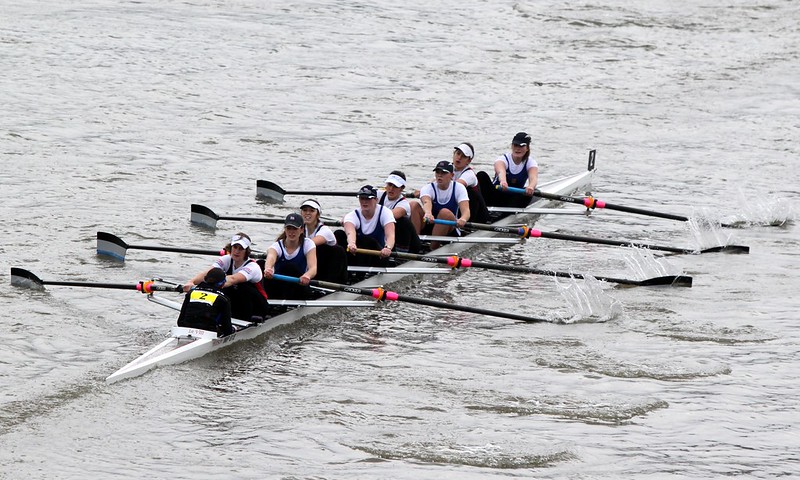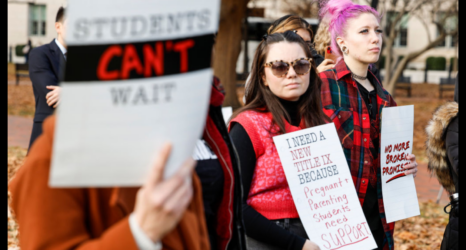“I understand that our teams don’t make as much money as football and basketball,” says Sage Ohlensehlen, captain of the women’s swim team at University of Iowa and lead plaintiff in a class-action Title IX lawsuit against the school. “But we trained just as hard and we have just as much love for our sport. We deserve to play just as much as any other athlete.”
University athletic directors across the country are using the coronavirus pandemic as an excuse to shift more resources toward men’s football and basketball. But courageous students like Sage Ohlensehlen are fighting back—and winning.
“I understand that our teams don’t make as much money as football and basketball,” says Ohlensehlen, who is captain of the women’s swim team at University of Iowa. “But we trained just as hard and we have just as much love for our sport. We deserve to play just as much as any other athlete.”
Ohlensehlen is the lead plaintiff in a class-action Title IX lawsuit against the University of Iowa and athletic director Gary Barta, who announced last August his plan to cut the women’s swimming and diving team along with three men’s teams at the end of the academic year. The lawsuit argues that cutting the women’s team violates Title IX because the University of Iowa has proportionally fewer athletic opportunities for women than men.
On Dec. 18, Ohlensehlen and her teammate Alexa Puccini testified in a federal courtroom in Des Moines before District Judge Stephanie M. Rose, who decided in their favor. Judge Rose issued a preliminary injunction stopping Barta from cutting the women’s team until there is a full hearing on the merits in the case, ruling that the plaintiffs had a good chance of succeeding on their Title IX claim and would suffer irreparable harm without an injunction.
“I’m so glad the outcome was positive,” says Ohlensehlen. “As athletes, females are undervalued. The society is way more interested in watching a male football game, as opposed to watching a female volleyball game. And that’s really sad because female sports are just as exciting, they work just as hard, their sports are just as great.”
Donna Lopiano, an expert in the case and president and founder of Sports Management Resources, agrees.
“They don’t value their women’s program in the same way as they value men,” Lopiano told Ms. “They feel as though they should be able to treat revenue-producing sports better than non-revenue producing sports, but most of the women’s programs are in the non-revenue category, and Title IX doesn’t let them. They have to treat men and women equally. It doesn’t matter what the revenues are.”
While they might unfortunately be able to get away cutting men’s teams, Title IX does not allow cuts to women’s teams if schools do not offer equitable athletic opportunities for both sexes, says Lopiano. “The reason they’re getting sued is if you’re not in compliance with Title IX, you can’t drop sports for the underrepresented sex.”
To comply with Title IX, an institution must show one of the following three factors:
- Male and female athletics participation that is roughly proportional to their enrollment at the institution;
- A history of expanding opportunities for the underrepresented sex; or
- A showing that an institution’s athletic offerings fully meet the interests and abilities of the underrepresented sex.
When a school cuts a women’s team despite demonstrated interest and ability, showing the first factor—proportional participation—is the only way to comply with Title IX.
Iowa fails on this measure, says Lopiano. Female students are currently 54.2 percent of undergraduates, but have only 48.6 percent of the athletic opportunities at the university. Iowa also artificially inflates the numbers of female athletes, according to sports economist and expert in the Iowa case, Andrew Zimbalist.
“They do a bunch of things to pad their numbers,” Zimbalist told Ms. “They load up their roster with many, many more players than they need, and when players notice that they’re not anywhere near getting involved in the games, they drop off the team, but they get counted. Another way they pad the numbers is to count male practice players as female athletes in women’s basketball.”
“They’re playing counting games,” says Lopiano. “They are reporting high numbers that are not justifiable. That’s what happened in Iowa. Iowa got caught cheating. For example, they reported a women’s rowing team of 92 where the average size of a rowing team is 60.”

Iowa is not alone in cuttings women’s teams despite their noncompliance with Title IX. Lopiano says cuts to non-revenue sports are part of a nationwide pattern at universities and schools right now. “COVID was a convenient excuse for most of these athletic directors to do what they would love to have done, what they knew they couldn’t do, without cover,” says Lopiano.
“There are a bunch of schools who say they have to cut in the name of financial exigencies, but the problem is that at the same time they’re pleading poor, they’re spending up the wazoo to protect their one or two revenue-producing sports. That’s the mentality of the athletic directors. They are not treating it as educational sports, but as a business.”
Lopiano says that schools could cut expenses rather than teams. “Everyone knows that we are in an economic downturn and that people are losing money. It’s intuitive that people say you may have to cut back, but any athletic director worth their oats knows that they don’t have to cut any sports in order to keep their athletic program intact. They just have to reduce expenses.”
Iowa is just one of over thirty schools that have cut women’s teams since the start of the pandemic, including Stanford, University of Minnesota, Clemson, George Washington and San Diego State.
“There are a lot of these cases that are coming down the pike,” says LoPiano. “Under the cover of COVID, folks are trying to drop women’s sports.”
Female athletes are challenging these cuts at many schools, including University of Connecticut (rowing), Dartmouth College (swimming and diving and golf) and Michigan State.
Several schools have recently settled Title IX lawsuits challenging cuts to women’s sports. Brown University settled a lawsuit late last year, backing down on cutting women’s fencing and equestrian teams. William and Mary reinstated women’s varsity gymnastics, swimming and volleyball after student athletes threatened a Title IX suit. Just last week East Carolina State University also settled a Title IX lawsuit and have pledged to reinstate women’s swimming, diving and tennis teams.
“COVID is an excuse to redistribute resources to continue to participate in the insatiable arms race,” says Lopiano. “In football and basketball, there are no limits to expenditures. We have seven and eight figure salaried coaches We build lavish football-only, athlete-only facilities. No one is saying no. There’s no national governance organization that says, I’m going to cap coaching expenditures, or I’m not going to allow you to build a building that all students can’t use. Without any restraints, everyone just continues to spend whatever is possible to spend. It’s unsustainable as an economic model. At some point you run into the wall.
“What you’re seeing right now is schools running into the revenue wall. There are no more new revenue sources so they’ve got to start killing their own children and feeding them to the beast. They are sacrificing all of their bottom, non-priority sports and shifting that money over to football and basketball.”
In fact, football and men’s basketball rarely generate a revenue surplus (meaning they spend more money than they bring in). While people often think of these sports as lucrative, they overwhelmingly function at a deficit. According to Zimbalist, only about 7 percent of football teams report surpluses, usually quite small. And these reported figures often do not count many of the team costs, such as facilities.
“There are two thousand higher ed institutions with athletic programs—1,100 are NCAA members—all run deficits and are subsidized by mandatory student fees or institutions’ general funds (tuition) except for 25 Division I FBS institutions in 2019,” says LoPiano.
Students, parents and alumnae protested the cut at University of Iowa. They raised $2 million to support the ongoing operations of the team, which costs around $500,000 a year, says Zimbalist. But Barta said it wasn’t enough—that they would have to raise tens of millions of dollars in order to preserve the team.
Zimbalist says this isn’t the first time that Iowa’s athletic director Gary Barta has faced discrimination charges. In 2017, Iowa entered into a $6.5 million settlement with former women’s field hockey coach Tracey Griesbaum, who alleged gender and sexual orientation discrimination after Barta fired her.
“Barta is a reactionary who’s been jeopardizing his department financially and morally for the last fourteen years,” says Zimbalist. “He gives out these massive contracts to the football coach—a 10-year contract for $4.9 million a year—and disregards Title IX.”
Last year, after eight Black football players filed a race discrimination complaint against the University, alleging racist behavior by assistant football coaches, Barta actually raised the coaches’ salaries, says Zimbalist.
“There is no reason that gender or race or sexual orientation should stop a person from what they rightfully deserve and have earned and have worked their entire lives to have,” says Ohlensehlen. “Count roster positions. Most schools are not compliant [with Title IX]. There are always far more men than there are women. It’s 2021. Gender bias should be a thing of the past. If we want to reach equality, we have to start holding these schools accountable.”
You may also like:
Our opponents are using the lame duck period—the time between now and when the new president is inaugurated, and a new Congress convenes—to do as much damage as they can. Help ensure Ms. remains strong and independent during this period of challenge and change. If you found this article helpful, please consider supporting our independent reporting and truth-telling for as little as $5 per month.





